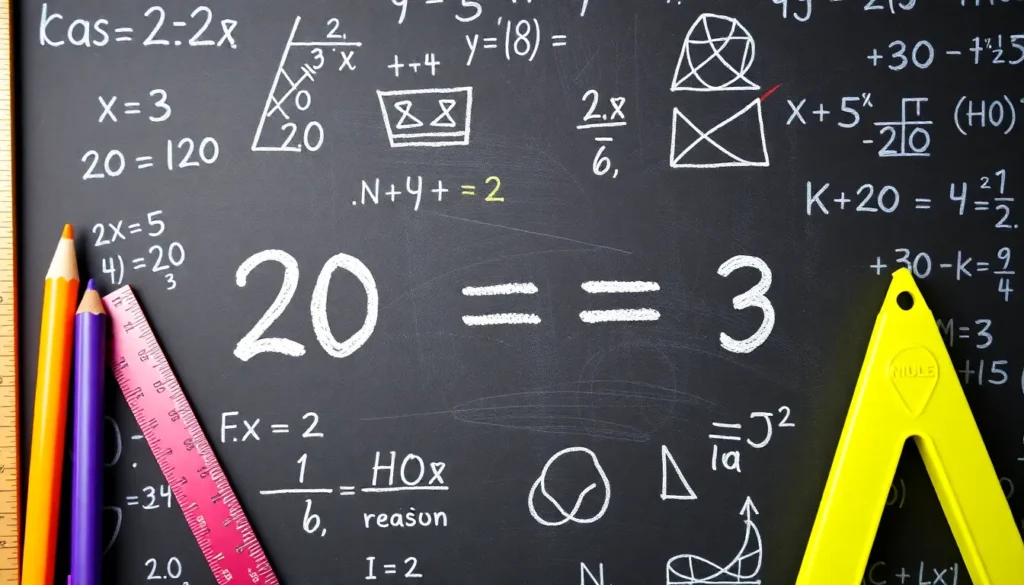Table of Contents
ToggleWhen it comes to numbers, few are as impressive as 20 raised to the power of 3. It’s like the superhero of math equations, ready to save the day with its sheer magnitude. Imagine a number so powerful it can make your calculator sweat. That’s right, folks. We’re diving into the world of exponents, where 20 to the power of 3 isn’t just a calculation—it’s a mathematical marvel.
Understanding Exponents
Exponents represent a fundamental aspect of mathematics, illustrating how many times a number, called the base, multiplies by itself. For example, when examining 20 raised to the power of 3, one finds that the exponent, which is 3, indicates that 20 multiplies by itself two additional times. This mathematical operation unfolds as 20 × 20 × 20.
Calculating 20 to the power of 3 results in 8,000. The breakdown of this operation emphasizes the expansive nature of exponents. Each multiplication exponentially increases the outcome, showcasing the growth potential inherent in exponentiation.
Another example includes 2 raised to the power of 4, which equals 16. This contrast highlights the rapid expansion that occurs with larger bases. Understanding the context of these calculations allows for a deeper appreciation of the results.
Exponents also facilitate operations in various scientific and engineering fields. Through powers, one can express large numbers succinctly. For instance, using exponents to represent 10^6 describes one million efficiently. Such representations simplify complex numerical concepts.
Understanding their role in equations reveals the power of exponents in shaping numerical expressions and calculations. The ability to manipulate and analyze these figures forms a cornerstone for various mathematical applications.
Calculating 20 To The Power Of 3

Calculating 20 raised to the power of 3 involves multiplying the base, 20, by itself three times. This process unfolds as 20 × 20 × 20, making the complexity clear.
Step-by-Step Breakdown
First, multiply 20 by 20 to get 400. Next, take the product, 400, and multiply it by 20. This results in 8,000. Such a straightforward approach reveals how exponents function, emphasizing the significance of each multiplication.
Final Calculation
The final result of 20 to the power of 3 is 8,000. This calculation showcases the power of large bases, significantly impacting numerical results. Exponential growth demonstrates how quickly numbers can escalate, with 20 cubed serving as a prime example. The outcome is significant, illustrating both mathematical principles and practical applications in fields such as science and engineering.
Practical Applications
Exponents play a crucial role across various fields, highlighting their importance in both theoretical and practical contexts.
Use in Mathematics
Mathematicians frequently utilize exponents in algebra, calculus, and beyond. Exponential functions model growth and decay, making them essential in analyzing trends in data. For instance, the equation of an exponential function often appears in compound interest calculations, where understanding the power of a number defines financial outcomes. Additionally, the properties of exponents simplify complex equations, enabling easier manipulation and solutions. Students encounter exponents early in their studies, laying a foundation for higher-level mathematics that builds upon these fundamental concepts. The practical implications of mastering exponents reach well beyond classrooms into advanced mathematical research.
Use in Real Life
Technology relies heavily on exponents in various applications. In computer science, for example, data storage is often represented in powers of two. One gigabyte equals 2^30 bytes, simplifying the representation of large quantities. Similarly, scientific measurements frequently employ exponents for clarity and efficiency. The speed of light is represented as approximately 3 × 10^8 meters per second, illustrating how exponents enable concise expression of vast numbers. Engineers utilize exponents to calculate forces and energy, applying these principles in innovative designs. Everyday life showcases the power of exponents, reinforcing their relevance in troubleshooting and problem-solving across different industries.
Comparing Powers of 20
Calculating (20^3) illuminates the rapid growth found in exponentiation. Compared to (2^4), which equals 16, (20^3) equals 8,000. This stark difference showcases the greater impact larger bases have in calculations.
Exploring (20^2), it results in 400. Continuing with this, multiplying 400 by 20 leads to the final value of 8,000. Each multiplication in this process compounds the total, highlighting how significant even slight changes in the base can alter the outcome drastically.
In practical applications, understanding different powers of 20 proves beneficial. (20^1), for instance, equals 20, serving as a basic reference point for growth. Incrementally increasing the exponent demonstrates an exponential leap in results, transforming the way numbers are perceived in various fields.
Exponentiation comes into play in technology. For instance, data storage often employs powers of 2, but when exploring larger quantities, powers of 10, like (10^6) for one million, provide clarity. Engineers and scientists frequently encounter these calculations, using them to express significant values succinctly.
Mathematics underlies many applications of exponents. In finance, the concept of compound interest thrives on these principles, allowing for more efficient financial modeling. As larger bases arrive on the scene, they introduce different scales of magnitude, influencing how industries approach mathematical challenges.
By examining these various powers of 20, one understands the dramatic escalation in numerical values. As exponents increase, they define new relationships between numbers, emphasizing their importance in mathematics and beyond.
Understanding 20 to the power of 3 reveals the incredible impact of exponents in mathematics. This calculation not only showcases the rapid growth of numbers but also highlights the importance of large bases in various applications. The result of 8,000 serves as a powerful example of how exponents can simplify complex mathematical concepts.
As industries continue to rely on these principles for problem-solving and modeling, the relevance of exponents remains undeniable. Embracing the potential of exponential growth can lead to deeper insights in fields ranging from finance to engineering. The journey through exponents illustrates their essential role in shaping our understanding of mathematics and its applications in everyday life.







